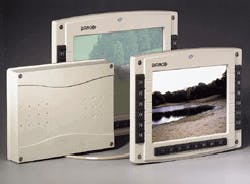By John Rhea
DULUTH, Ga. — Engineers at Barco Inc. are prototyping a family of liquid crystal display (LCD) panels for combat vehicles in which systems integrators can separate the panels as far as 15 feet apart from the control module.
Evaluating the units are specialists at Systems & Electronics Inc. (SEI) in St. Louis for their new Striker 2 surveillance and fire support variant of the High Mobility Multi-purpose Wheeled Vehicle — better known as the Humvee.
The idea is to accept a variety of sensor inputs ranging from live video, forward-looking infrared, computer-generated graphics, and text on screen displays overlaid on maps and visual scenes, and then integrate them to give combat personnel a coordinated picture of the battlefield, Barco officials explain.
The new line, designated Vector, consists of 10-, 12-, and 15-inch LCD panels that each weigh about two pounds and cost $5,000 to $10,000. Various keys for data entry can also surround the screens, much like a personal computer.
The control panel coordinates the inputs from the sensors for display on individual panels and can provide optional video recording in the NTSC mode used in the United States or PAL mode in Europe. Another option is touch screen input at the panel.
SEI personnel are evaluating the displays for the Striker 2 scout vehicle in an attempt to reduce the time lag for ritical battlefield information and increase situational awareness. These vehicles will be tailored to user needs, including overseas military forces, and requite a mix-and-match capability of subsystems based on a common system architecture.
Among the options for the mast-mounted sensors, for example, are color day camera, thermal imager, laser range finder, laser designator, radar, low-light-level camera, and acoustic sensor array.
Barco engineers are enabling vetronics integrators to separate displays and display control circuitry to save space.

